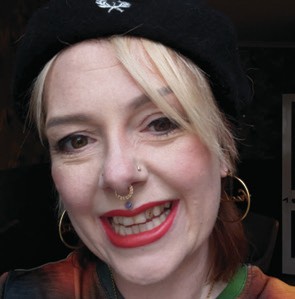BUSINESS MATTERS
YOU’RE HIRED!
Are you searching for a new nail or beauty role but unsure how to make your application shine? Check out REBECCA HITCHON’S roundup of advice
In February’s issue of Scratch, we explored the recruitment process and ways nail and beauty businesses can find a well-suited employee. Now it’s time to put the focus on jobseekers. Applying for a nail or beauty role isn’t easy: singing your praises to a stranger often doesn’t come naturally, so let’s explore top tips from experts for finding success in the job application process...
FINDING THE RIGHT ROLE FOR YOU
Linda Hill, founder of award-winning aesthetic and beauty recruitment agency, Linda Hill Recruitment, shares eight factors to consider when searching for a new position:
• Location.
• Reputation of the company – in the industry and among clients.

Linda Hill
• Quality of the products and services offered.
• Basic salary and commission structure.
• Working hours.
• Client demographics.
• Work culture and environment, which is sometimes evident through social media.
• Opportunities for professional development and career advancement.
“It is very important to do your homework on the business you wish to apply to,” adds Zara Evry, owner & director of Edinburgh nail salon, Cute But Deadly Nail Co. The experienced nail pro rents out desks to nail artists seeking a creative, team environment with the benefits of being self-employed. “Many of our renters have contacted me expressing an interest in working in the salon, so it’s worth putting yourself out there. This initiative and a great social media portfolio make me inclined to set up an interview,” she reveals.
“When searching for a salon role, ask yourself if you are seeking a brand you can be heavily involved in, and if the salon, its clients and atmosphere suit your ethos and aesthetic. Staying true to who you are is crucial; not every salon will be for you, and you won’t suit every salon.”

Zara Evry
SOCIAL MEDIA SUCCESS
Beyond your job application, a prospective employer is likely to look at your social media accounts to find out more about your personality and professionalism.
“Your social media accounts are a reflection of you. Think of them as your digital branding,” says Alicia Humphreys, owner of Pink Fox Salon Socials, a social media management company for salons.

Alicia Humphreys
“Ensure that your personal account conveys a positive image, aligning with the values of the business you want to join. Showcase your passions and let your personality shine through,” she continues. “Make sure that your business account displays your best work, along with your personal and business values. Sharing valuable content, such as aftercare advice, not only positions you as an authority in your field, but demonstrates your commitment to the industry.”
PRESENTATION POINTERS
CV
“The aim of a CV is to sell yourself and hold the attention of the person reading it,” notes Linda Hill. “Here are 10 tips to consider:
1. If possible, limit your CV to two pages.
2. Ensure your name and contact details are clearly visible at the top.
3. Choose one font to use throughout and avoid curly typeface.
4. Check that spacing is consistent.
5. Make headings, such as ‘education’ or ‘work history’, stand out by underlining them or using bold typeface.
6. Name the companies where you worked previously, as well as the job titles, to give employers an instant overview of your experience.
7.
Present employment dates consistently and in chronological order, starting with most recent. Include the dates your education started and finished, so the length of courses is clear.
8.
Use bullet points to list the responsibilities of previous positions, and don’t misrepresent your skills.
9.
List the treatments you provide. Often therapists and nail techs will state that they provide ‘all treatments’, but be clear about what this means.
10.
Tailor your application to showcase how your skills and experience align with a brand’s offerings and values.”
Interview
“In my book, Beauty Therapist to Entrepreneur, I write about the seven mistakes people make during interviews,” shares Linda Hill. “These are:
1. Not making a good first impression: Be mindful of the impact you make during the first seven seconds of the interview. Smile and make eye contact.
2.
Not researching the company: Not being able to answer questions about the company suggests a lack of preparation and interest in the brand, which are indicators of your enthusiasm and commitment to the role.
3.
Asking the wrong questions: This isn’t so much about the questions, as it is about their timing. For example, asking about sick pay and holiday entitlement is irrelevant if you haven’t received an offer, and can give the wrong impression about your priorities.
4.
Coming across as a ‘know-it-all’: Often, interviewees fall into the trap of being over-confident. Questions that appear to challenge the interviewer can detract from building a positive connection.
5.
Not verbalising your strengths: Have a list of strengths ready to share with the interviewer.
6.
Talking about salary: The first interview is primarily about assessing fit. Introducing salary discussions too early can give the impression that compensation is your sole interest.
7.
Saying you want to learn: When you emphasise the fact that you want to learn and develop, the focus switches to the gaps in your education and skill set. Instead, focus on what you do know and the value you can add.”
“It doesn’t matter whether a salon owner is employing staff or inviting self-employed workers to run a business within theirs, it is vital that professionals show they will clearly uphold the standards and reputation of the salon, essentially as brand ambassadors,” comments Zara Evry. “Before bringing self-employed pros into Cute But Deadly Nail Co, I carry out interviews and ask other renters to join us for a half day, so everyone can get to know each other. It’s important that all my renters work well together in the space. During the interview, I’m not looking for the most technically incredible artist the world has seen – good nail knowledge is essential, but the candidate must be driven and passionate.”

Linda McCandlish
TECH TALK
Nail artist at Cute But Deadly Nail Co, Linda McCandlish, shares her experiences of joining the team...
“I applied to work at Cute But Deadly by reaching out on Instagram, which led to Zara Evry inviting me for an informal chat to discuss my experience as a nail artist and detail how the salon is run,” she recalls. “I didn’t feel pressure to perform in a certain way or appear perfect during the interview; I felt encouraged to be myself. I think I was successful in getting a job at the salon, because I was honest about where I was at in my journey as a nail artist and how I’d like to evolve. I was very enthusiastic about advancing my career, which showed Zara I had a great potential.” www.cutebutdeadly.co.uk
TRADE TEST
“The function of a trade test is to determine your training needs and the standard of your treatments,” explains Linda Hill. She advises wearing a clean uniform with flat, closed-toe shoes, tying hair up if long and ensuring nails are immaculate.
“When preparing for a trade test, plan the order you will carry out the treatments if asked to do more than one,” she comments. “Make a point of washing your hands, signalling to the interviewer that you’re focused on hygiene. Explain exactly what will happen during the treatment/s and what you expect from the client.
“After the trade test, don’t ask the interviewer when you can expect to hear back,” Linda continues. “Instead, thank them for their time and say you look forward to hearing from them. If you don’t hear back, follow up by sending an email to say thank you again or highlighting your interest in the role.”
Guest editor, Danny Haile, comments:
“Being a nail technician is tough work! You are part therapist, part craftsman, and sometimes even part magician. A great nail tech must be a people person who enjoys being in the presence of others, but at the same time makes their boundaries clear with clients. It’s a fine mix of giving the customer what they want, while being an expert and guiding the treatment process.”